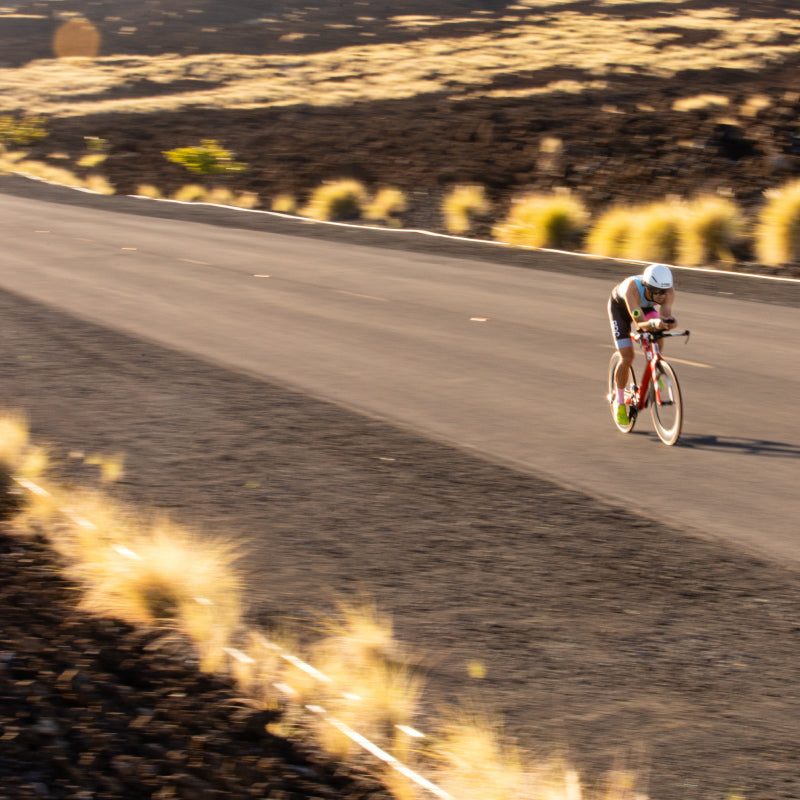In February 2025, IRONMAN introduced new updates to their water bottle and hydration system regulations, specifically targeting the way athletes carry water during the bike segment of the race. These new rules aim to ensure fairness, safety, and efficiency in hydration management for both elite and amateur athletes.
The New Hydration System Rules
The updated IRONMAN rules establish new volume capacity limits for both front-mounted and rear-mounted water bottles and hydration systems:
Front-Mounted Hydration: The combined maximum volume for all water bottles and hydration systems mounted on the front end of the bicycle is now 2 liters (68 ounces). This limit applies to all bottles or hydration systems mounted on the handlebars or in front of the athlete. It is important to note that this restriction does not apply to bottles or hydration systems located inside the frame triangle or within the bike frame itself.
Rear-Mounted Hydration: Athletes are allowed to carry up to two 1-liter (34 ounces) bottles in water bottle holders mounted behind the saddle. Similar to the front-mounted systems, this restriction excludes bottles attached to the bike’s main frame or within the frame itself, allowing some flexibility in how hydration is stored.
Background: The 2022 Gustav Iden Controversy
The new rules are a direct response to a growing trend that started in 2022 when reigning Ironman World Champion Gustav Iden employed a controversial hydration strategy during the Ironman World Championship in Kona. Iden stuffed a water bottle down the front of his kit—a hack that had been tested and published by Triathlete, revealing a drag reduction of 5.4% to 9%. As more athletes adopted this strategy, the IRONMAN organization quickly moved to ban it, citing that the technique constituted an "unfair use of chest fairings."
This move reflects IRONMAN's commitment to maintaining fair competition while ensuring that all athletes are subject to the same conditions during the race.
A Closer Look at Hydration Needs and Safety Concerns
Hydration is critical in long-distance races like the Ironman. Elite athletes, such as Lionel Sanders, have publicly shared their struggles with hydration during the race. In the 2019 Ironman World Championship in Kona, Sanders lost 272 oz (17 lbs, or approximately 8L) of fluid during the bike leg. He noted that he sweat a minimum of 2L per hour on the bike, which meant he lost a minimum of 8L during the first four hours. He consumed 4 bottles of Gatorade (710mL each) for a total of 2.84L—a small fraction of the fluids he needed to replace.
This highlights the challenge of staying hydrated throughout the grueling 112-mile bike course and the need for accessible hydration systems.
Why Implement the New Rules?
In addition to ensuring fairness, the new IRONMAN race rules have a safety component. Adding extra fluid capacity too far forward on the bicycle—especially beyond the wheel and cockpit—could alter an athlete’s center of gravity. This could create unintended consequences, particularly for age-group athletes or those with less expert handling skills. The change aims to prevent potential accidents due to improperly distributed weight on the bike.
How Much Hydration Do Athletes Really Need?
Here’s a breakdown of hydration volumes allowed under the new rules, and how they relate to typical race conditions:
Maximum Hydration Allowed: Athletes can now carry up to 136 oz (4 liters) of hydration between front and rear systems, plus any additional fluids inside the main frame of the bike. For most cyclists, this could mean two standard 22 oz bottles in the frame, bringing the total to about 180 oz (5.3 liters) of fluid.
Hydration for Elite Athletes: With an average cycling time of 4 to 4.5 hours for elite athletes, the maximum hydration volume of 180 oz breaks down to approximately 40 oz per hour of cycling.
Hydration for Amateur Athletes: For non-elite athletes, who typically take 5 to 7 hours on the bike leg, this total hydration would equate to roughly 28.6 oz per hour for a 6.3-hour cycling time.
How Can Athletes Use Nix Data to Inform Race Day Hydration Strategies?
Given that the average cycling sweat rate in outdoor conditions is about 30 oz per hour according to the Nix data, the new hydration volume limits appear to provide a reasonable buffer for athletes, as long as they don’t have a higher sweat rate.
When preparing for an IRONMAN race with Nix, athletes should aim to simulate race conditions as closely as possible, closely tracking their sweat and electrolyte loss rates during these training sessions. This approach allows them to better understand their sweat profile and anticipate how their body will react on race day.
For athletes with a lower sweat rate, the new IRONMAN hydration rules are unlikely to significantly impact their hydration strategy. However, athletes with a higher sweat rate—especially those losing more than 30 oz per hour—may find it challenging to carry enough fluids to fully replace what they're losing during the race, potentially requiring them to rethink their hydration plans to ensure optimal performance and recovery.
What Does This Mean for IRONMAN Athletes?
The new hydration system rules introduce a streamlined, fair approach to managing hydration during the race. Athletes will need to adapt their hydration strategies, choosing between front and rear-mounted hydration systems or utilizing space within the bike frame. However, the rules aim to prevent any unfair advantages while maintaining athlete safety and promoting an equitable racing environment.
For those competing in upcoming IRONMAN races, these updates mean that hydration management will require careful planning. Athletes should ensure that their hydration systems adhere to the new limits while considering how to manage fluid intake during the race, especially on long bike courses.
Conclusion
The 2025 IRONMAN hydration system updates reflect a broader commitment to fairness and safety in triathlon racing. By limiting the volume and placement of hydration systems, IRONMAN hopes to provide a level playing field for athletes at all levels while reducing safety risks associated with poorly distributed weight on the bike. As these changes take effect, competitors will need to adapt their strategies and prepare for the challenges that lie ahead.





